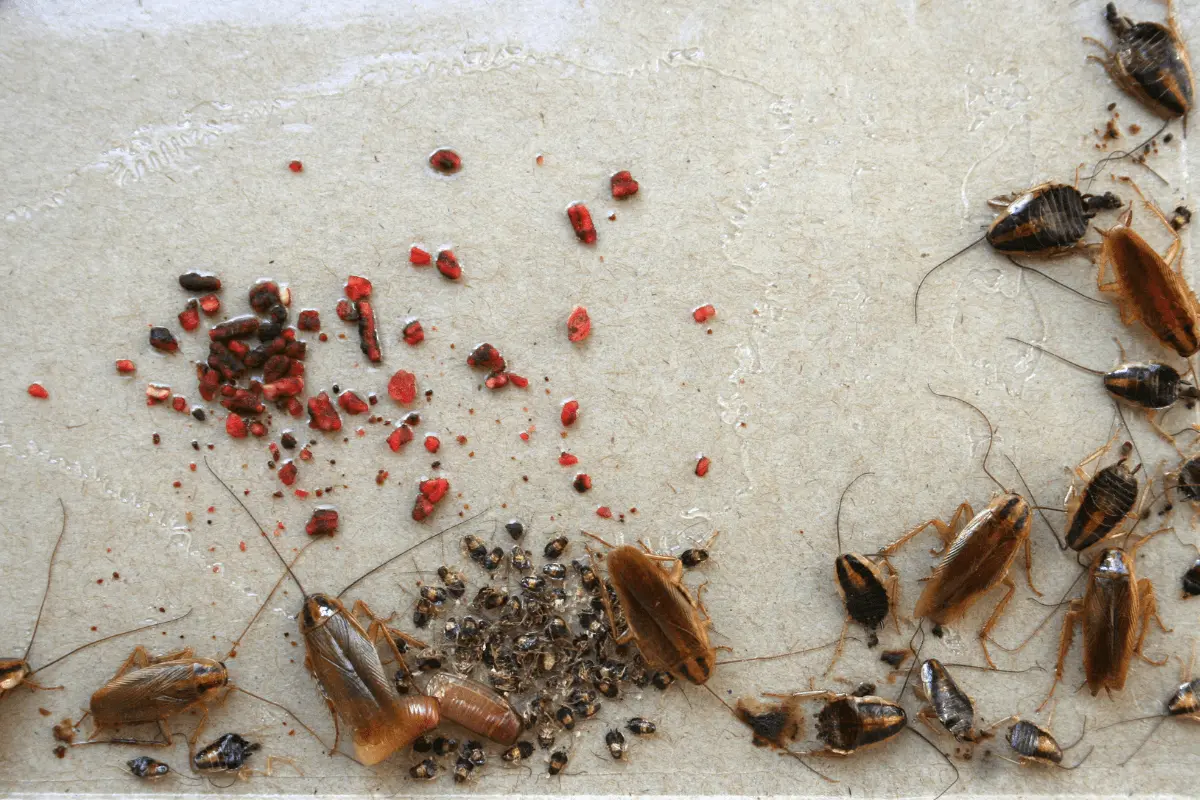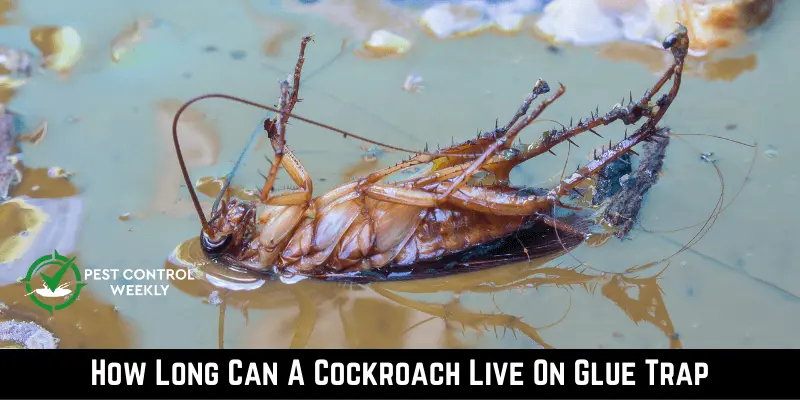Cockroaches are notorious household pests due to their adaptability and ability to thrive in various conditions. These pests can go without food for up to a month, but how long can a cockroach live on glue trap?
Experts say a cockroach can live in a glue trap for seven days. The insect will slowly die from starvation, dehydration, or exhaustion during this time. A cockroach trapped in the glue will struggle to escape.
This article will discuss the average survival rate of a cockroach on a glue trap and other methods for exterminating these pesky insects.
How Long Does It Take For A Cockroach To Die On A Glue Trap?
According to Environmental Entomology several things can affect how long it takes for a cockroach to die in a glue trap. First, it will depend on how big the cockroach is. Bigger cockroaches will take longer to die than smaller ones.
The glue trap is the second factor influencing how quickly a cockroach dies. Some traps have stronger glue, stopping the cockroach from moving faster.
A glue trap can generally kill a cockroach anywhere from a few hours to a few days. However, keep in mind that the cockroach may have to undergo much pain and suffering before it finally succumbs to the procedure.
How Do Glue Traps Work To Kill Cockroaches?
People often use glue traps to kill cockroaches. The traps use sticky glue to stop the cockroach from moving. Since it can’t move, it will eventually die.
The glue trap has a layer of adhesive on its surface, which makes it very sticky. The cockroach’s legs and body cling to the glue when it walks over the trap, making it stick. The cockroach will die trying to escape since it will become more and more trapped.
Place glue traps where cockroaches are most likely, like near trash cans, on edges, or the baseboards. It’s important to effectively dispose of a cockroach and prevent others from entering the trap after one has been caught.
How Many Cockroaches Can Be Caught On One Glue Trap?
How many cockroaches one glue trap can catch depends on how big the trap is and how bad the problem is. Most of the time, one glue trap can catch anywhere from one to several cockroaches at once.

But if there are a lot of cockroaches, you should use more than one glue trap to catch more of them. Also, it’s important to check on the glue traps often and replace them when they get full or dusty to ensure they work.
How Often Should Glue Traps Be Checked For Trapped Cockroaches?
To catch cockroaches with glue traps, you must know how often to check them for insects. Checking glue traps often is important to ensure they work and avoid possible health risks.
Check glue traps daily or every other day. But the number of checks may change based on the problem and where the traps are set.
For example, if you have a lot of cockroaches, check the glue traps more often, like every couple of hours. On the other hand, if the problem is small, you may only need to check the traps once a week.
What Is The Best Way To Dispose Of A Glue Trap With A Cockroach On It?
When throwing away glue traps with cockroaches in them, it is important to take the right steps to avoid any possible health risks. Here’s how to do it safely and effectively:
Quick Steps
- First, wear disposable gloves so you don’t touch the cockroach or the glue.
- Then, carefully pick up the trap and put it in a plastic bag without breaking it.
- To prevent escape, seal the bag and throw it away.
- To avoid getting sick, washing your hands well with soap and warm water after handling the glue trap and gloves is important.
- It’s also a good idea to clean the area where the glue trap was put to stop any more bugs from coming in.
- By doing these things, you can safely and effectively get rid of glue traps with cockroaches, avoiding any possible health risks and ensuring your home stays pest-free.
FAQs
Can A Cockroach Survive On A Glue Trap?
A cockroach might be able to live on a glue trap, but it’s not likely. Glue traps keep insects stuck in place until they die from dehydration or starvation. But a cockroach might be able to live if it can get out of the trap or if it gets caught but can get out on its own.
Can A Cockroach Escape From A Glue Trap?
Once a cockroach is caught in a glue trap, it doesn’t usually get out very easily. The glue on the trap is meant to keep insects stuck, making it hard for them to get out. But there is always a chance that a very strong or smart cockroach could find a way out.
Can Glue Traps Be Reused After A Cockroach Is Caught?
Technically, glue traps can be used again after catching a cockroach, but it usually is a bad idea. Once an insect is caught in the glue, it can leave behind bits of dirt and bacteria that could attract more insects or be bad for your health. Most of the time, it’s best just to throw away the trap and get a new one.
How Often Do You Change Cockroach Glue Traps?
Changing cockroach glue traps often is a good idea, especially if you have a bad infestation. The number of cockroaches being caught and the number of traps placed will determine how often the traps need to be replaced. The traps should be checked at least once a week, and any insects caught should be removed.
How Do You Remove Cockroaches From A Glue Trap?
Getting a cockroach out of a glue trap can be hard because the glue is meant to be very sticky. One option is carefully grabbing the bug with tongs or tweezers and pulling it off the trap. You could also use a little bit of vegetable oil or rubbing alcohol to soften the glue around the bug and then gently take it out of the trap.
Do Cockroaches Know To Avoid Traps?
Cockroaches aren’t smart, but they can smell and see the danger. If they get caught in a trap and escape, they might be more careful the next time they see one like it. But there is no evidence that cockroaches know about or can avoid traps.
Final Thoghts
To sum up, a cockroach might get out of a glue trap alive, but it’s quite difficult. The pests cannot escape the trap’s sticky adhesive until they die from dryness or starvation. Nonetheless, survival may be possible for a cockroach that escapes the trap. Still, it’s best to acquire a new trap because the insect may have left behind bits of dirt or bacteria that could attract more pests or harm your health.
References
Gondhalekar AD, Appel AG, Thomas GM, Romero A. A Review of Alternative Management Tactics Employed for the Control of Various Cockroach Species (Order: Blattodea) in the USA. Insects. 2021 Jun 12;12(6):550. doi: 10.3390/insects12060550. PMID: 34204810; PMCID: PMC8231608.
Hottel BA, Pereira RM, Gezan SA, Koehler PG. Sticky Trap Design Considerations for Entrapping Bed Bugs. Insects. 2019 Jun 19;10(6):177. doi: 10.3390/insects10060177. PMID: 31248145; PMCID: PMC6628081.
Wang, Changlu & Bennett, Gary. (2006). Comparison of Cockroach Traps and Attractants for Monitoring German Cockroaches (Dictyoptera: Blattellidae). Environmental Entomology. 35. 765-770. 10.1603/0046-225X-35.3.765.
